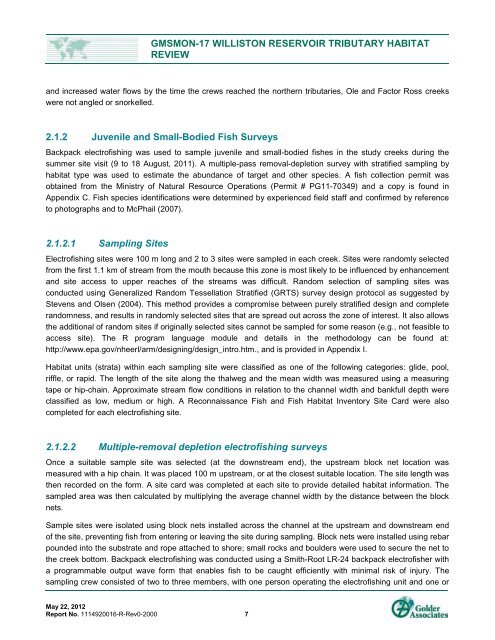GMSMON-17 WILLISTON RESERVOIR TRIBUTARY - BC Hydro
GMSMON-17 WILLISTON RESERVOIR TRIBUTARY - BC Hydro
GMSMON-17 WILLISTON RESERVOIR TRIBUTARY - BC Hydro
You also want an ePaper? Increase the reach of your titles
YUMPU automatically turns print PDFs into web optimized ePapers that Google loves.
May 22, 2012<br />
Report No. 1114920016-R-Rev0-2000 7<br />
<strong>GMSMON</strong>-<strong>17</strong> <strong>WILLISTON</strong> <strong>RESERVOIR</strong> <strong>TRIBUTARY</strong> HABITAT<br />
REVIEW<br />
and increased water flows by the time the crews reached the northern tributaries, Ole and Factor Ross creeks<br />
were not angled or snorkelled.<br />
2.1.2 Juvenile and Small-Bodied Fish Surveys<br />
Backpack electrofishing was used to sample juvenile and small-bodied fishes in the study creeks during the<br />
summer site visit (9 to 18 August, 2011). A multiple-pass removal-depletion survey with stratified sampling by<br />
habitat type was used to estimate the abundance of target and other species. A fish collection permit was<br />
obtained from the Ministry of Natural Resource Operations (Permit # PG11-70349) and a copy is found in<br />
Appendix C. Fish species identifications were determined by experienced field staff and confirmed by reference<br />
to photographs and to McPhail (2007).<br />
2.1.2.1 Sampling Sites<br />
Electrofishing sites were 100 m long and 2 to 3 sites were sampled in each creek. Sites were randomly selected<br />
from the first 1.1 km of stream from the mouth because this zone is most likely to be influenced by enhancement<br />
and site access to upper reaches of the streams was difficult. Random selection of sampling sites was<br />
conducted using Generalized Random Tessellation Stratified (GRTS) survey design protocol as suggested by<br />
Stevens and Olsen (2004). This method provides a compromise between purely stratified design and complete<br />
randomness, and results in randomly selected sites that are spread out across the zone of interest. It also allows<br />
the additional of random sites if originally selected sites cannot be sampled for some reason (e.g., not feasible to<br />
access site). The R program language module and details in the methodology can be found at:<br />
http://www.epa.gov/nheerl/arm/designing/design_intro.htm., and is provided in Appendix I.<br />
Habitat units (strata) within each sampling site were classified as one of the following categories: glide, pool,<br />
riffle, or rapid. The length of the site along the thalweg and the mean width was measured using a measuring<br />
tape or hip-chain. Approximate stream flow conditions in relation to the channel width and bankfull depth were<br />
classified as low, medium or high. A Reconnaissance Fish and Fish Habitat Inventory Site Card were also<br />
completed for each electrofishing site.<br />
2.1.2.2 Multiple-removal depletion electrofishing surveys<br />
Once a suitable sample site was selected (at the downstream end), the upstream block net location was<br />
measured with a hip chain. It was placed 100 m upstream, or at the closest suitable location. The site length was<br />
then recorded on the form. A site card was completed at each site to provide detailed habitat information. The<br />
sampled area was then calculated by multiplying the average channel width by the distance between the block<br />
nets.<br />
Sample sites were isolated using block nets installed across the channel at the upstream and downstream end<br />
of the site, preventing fish from entering or leaving the site during sampling. Block nets were installed using rebar<br />
pounded into the substrate and rope attached to shore; small rocks and boulders were used to secure the net to<br />
the creek bottom. Backpack electrofishing was conducted using a Smith-Root LR-24 backpack electrofisher with<br />
a programmable output wave form that enables fish to be caught efficiently with minimal risk of injury. The<br />
sampling crew consisted of two to three members, with one person operating the electrofishing unit and one or
















